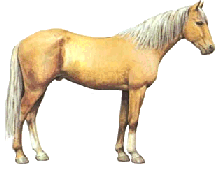 Registries have been established for this color, but it is not an actual breed. Those registries have described palomino as that it should be the color of twenty-two carat gold. There could be a great deal of discussion as to any difference there could be between ten, fourteen or twenty-two carat gold. Since there is no visible difference, palomino is best described as a golden color.
Registries have been established for this color, but it is not an actual breed. Those registries have described palomino as that it should be the color of twenty-two carat gold. There could be a great deal of discussion as to any difference there could be between ten, fourteen or twenty-two carat gold. Since there is no visible difference, palomino is best described as a golden color.
The gold color of palomino is reflected in the manner with which the pigment pattern refracts light. This is caused by the pigment being expelled outward through the hair shaft from the follicle. The follicle's opening is so constricted that when the pigment is propelled by its electrons, it enters the shaft in a "smear" rather than a full-bodied spherically-shaped pigment deposit. This "smear" coats the inside of the hair shaft and is so thinly spread that light refraction gives off the golden palomino color.
Look for an update on this article with genetic information soon.
Source:
|
Published April 1996 in the North West Breyer Horse Club newsletter. (em)

|
© 1997-2007
NW Breyer Horse Club & Refiner of Gold Creations Equinealities in place since 1997, Section in place 2001, Updated 3/13/2007 |



|
| ||

|
|||||
 The lightly-pigmented hide of the palomino horse is useful but not nearly as durable as self and intense colors. The hooves are usually amber and have insufficient pigment. They are more susceptible to brittleness and thus are subject to cracking. The palomino color does not tend to sunburn, however the hide will not withstand extreme amounts of heat or pressure. This color gorse is never found in the sand-scalding regions of the world. Though manes and tails of horses of the purest palomino color are generally lighter than body color, they are seldom "pure" white.
The lightly-pigmented hide of the palomino horse is useful but not nearly as durable as self and intense colors. The hooves are usually amber and have insufficient pigment. They are more susceptible to brittleness and thus are subject to cracking. The palomino color does not tend to sunburn, however the hide will not withstand extreme amounts of heat or pressure. This color gorse is never found in the sand-scalding regions of the world. Though manes and tails of horses of the purest palomino color are generally lighter than body color, they are seldom "pure" white.
 For more information on Palominos, visit:
For more information on Palominos, visit:
 See also:
See also:
